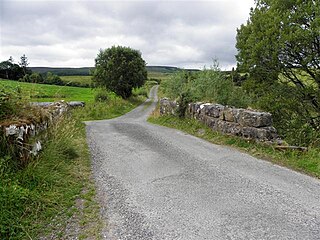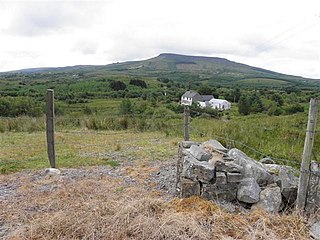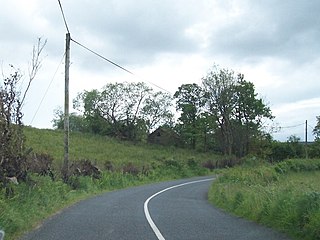Moneensauran is a townland in the civil parish of Templeport, County Cavan, Ireland. It lies within the Roman Catholic parish of Glangevlin and barony of Tullyhaw.

Bellavally Upper, in Gaelic= 'Béal an Bhealaigh Uachtarach', meaning The Upper Entrance to the Pass or Gap, is a townland in the civil parish of Templeport, County Cavan, Ireland. The local pronunciation is Bealbally. It lies in the Roman Catholic parish of Glangevlin and barony of Tullyhaw.
Bursan, in Gaelic 'Bus-an' possibly meaning The Little Mouth, is a townland in the civil parish of Templeport, County Cavan, Ireland. It lies in the Roman Catholic parish of Glangevlin and barony of Tullyhaw.
Corracleigh, an Anglicisation of the Gaelic, ‘Corr na Cloiche’ meaning The Round Hill of the Stone, is a townland in the civil parish of Templeport, County Cavan, Ireland. It lies in the Roman Catholic parish of Glangevlin and barony of Tullyhaw. The local pronunciation is Curracliff.

Creea, an Anglicisation of the Gaelic, either ‘Críocha’ meaning The Territory or the Boundaries, or ‘Cré’ meaning Clay, or ‘Croí’ meaning The Heart or 'Criathar' meaning a Sieve, is a townland in the civil parish of Templeport, County Cavan, Ireland. It lies in the Roman Catholic parish of Glangevlin and barony of Tullyhaw.

Curraghglass, an Anglicisation of the Gaelic, ‘Currach Glas’ meaning The Green Moor, is a townland in the civil parish of Templeport, County Cavan, Ireland. It lies in the Roman Catholic parish of Glangevlin and barony of Tullyhaw.

Derrylahan, an Anglicisation of the Gaelic, ‘Doire Leathan’ meaning The Wide Oak-wood, is a townland in the civil parish of Templeport, County Cavan, Ireland. It lies in the Roman Catholic parish of Glangevlin and barony of Tullyhaw.

Derrynananta Lower, an Anglicisation of the Gaelic, ‘Doire na Neannta Íochtar’, meaning The Lower Oak-wood of the Nettles, is a townland in the civil parish of Templeport, County Cavan, Ireland. It lies in the Roman Catholic parish of Glangevlin and barony of Tullyhaw.

Derrynananta Upper, an Anglicisation of the Gaelic, ‘Doire na Neannta Uachtarach’, meaning The Upper Oak-wood of the Nettles, is a townland in the civil parish of Templeport, County Cavan, Ireland. The townland lies in the Roman Catholic parish of Glangevlin and barony of Tullyhaw. In the 19th century, it was also known as Derrynananta Lodge, after a shooting-lodge there called Glengavlen Lodge, which was owned by John Cole, 2nd Earl of Enniskillen.

Derrynatuan, an Anglicisation of the Gaelic, either ‘Doirín an tSuain’, meaning The Little Oak-wood of the Rest or Sleep, or ‘Doire na Tóin’, meaning The Oak-wood of the Low Lying Land, or ‘Doire na Tamhan’, meaning The Oak-wood of the Tree-Stumps, is a townland in the civil parish of Templeport, County Cavan, Ireland. It lies in the Roman Catholic parish of Glangevlin and barony of Tullyhaw.

Drumhurrin, an Anglicisation of the Gaelic ‘Droim Shoirn’, meaning The Hill-Ridge of the Lime-Kiln or Furnace, is a townland in the civil parish of Templeport, County Cavan, Ireland. It lies in the Roman Catholic parish of Glangevlin and barony of Tullyhaw.
Garvalt Lower, an Anglicisation of the Gaelic, ‘Garbhalt Íochtar’, meaning The Lower Rough Gorge, is a townland in the civil parish of Templeport, County Cavan, Ireland. It lies in the Roman Catholic parish of Glangevlin and barony of Tullyhaw.
Gowlat, an Anglicisation of the Gaelic, 'Gabhla', meaning The Forks, is a townland in the civil parish of Templeport, County Cavan, Ireland. It lies in the Roman Catholic parish of Glangevlin and barony of Tullyhaw.
Knockgorm, an Anglicisation of the Gaelic 'Cnoc Gorm', meaning The Blue Hill, is a townland in the civil parish of Templeport, County Cavan, Ireland. It lies in the Roman Catholic parish of Glangevlin and barony of Tullyhaw.
Legatraghta, an Anglicisation of the Gaelic ‘Lag an tSneachta’, meaning The Hollow of the Snow, is a townland in the civil parish of Templeport, County Cavan, Ireland. It lies in the Roman Catholic parish of Glangevlin and barony of Tullyhaw.
Mullaghlea Glen, is a townland in the civil parish of Templeport, County Cavan, Ireland. It lies in the Roman Catholic parish of Glangevlin and barony of Tullyhaw.
Mully Lower, an Anglicisation of the Gaelic, ‘Mullach Íochtar’ meaning The Lower Summit of the Hill, is a townland in the civil parish of Templeport, County Cavan, Ireland. It lies in the Roman Catholic parish of Glangevlin and barony of Tullyhaw.

Mully Upper, an Anglicisation of the Gaelic, ‘Mullach Uachtar’ meaning The Upper Summit of the Hill, is a townland in the civil parish of Templeport, County Cavan, Ireland. It lies in the Roman Catholic parish of Glangevlin and barony of Tullyhaw.

Tullynacross, an Anglicisation of the Gaelic, ‘Tulaigh na Croise’ meaning The Hill of the Cross, is a townland in the civil parish of Templeport, County Cavan, Ireland. It lies in the Roman Catholic parish of Glangevlin and barony of Tullyhaw.












